#schlossberg castle
Text

Schlossberg Castle, AUSTRIA
106 notes
·
View notes
Text
Schlossberger Castle, Tura, Hungary

0 notes
Text
Schlossberger Castle, Tura, Hungary

0 notes
Photo
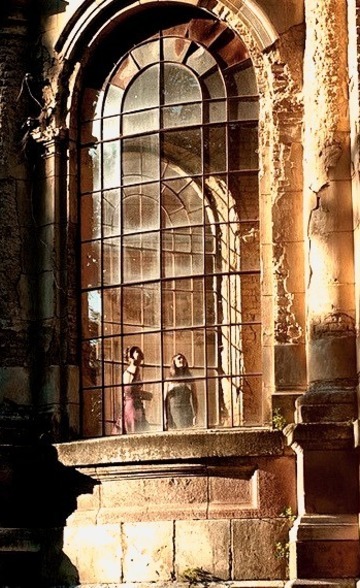
Schlossberger Castle, Tura, Hungary
0 notes
Photo

Schlossberger Castle, Tura, Hungary
0 notes
Text
0 notes
Text
after the BLADE MUSEUM
Our adventures now include a car, which is fun and exciting, and allowed us to drive out to Schlossberg castle. Turns out they’re doing a whole bunch of restoration and reconstruction on it, but it was still pretty cool.
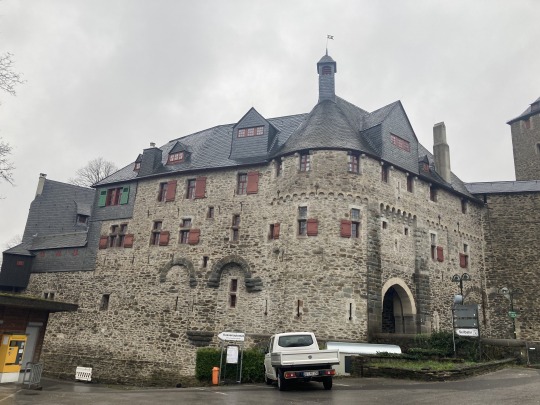
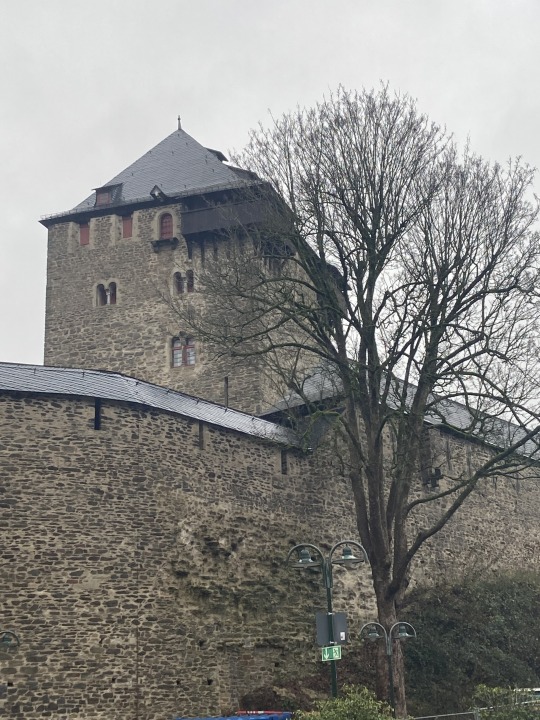




0 notes
Text
Traveling in Europe Austria
Graz On the Mur River
The capital of Styria and Austria’s second-largest city is Graz. It has a lovely location in the shadow of Schlossberg Hill and is situated on both sides of the Mur River. There are beautiful views all around and the city itself is charming with lots to see and delight in. It was actually the castle upon The Schlossberg that gave the city its name. It came from the Slavonic…

View On WordPress
0 notes
Text
Franken, Silvaner's Heimatland

Würzburg's famous castle and Stein vineyard facing the Main.
Franken, by the numbers
Hectares under vine: 6,306 hectares (2023), sixth largest in Germany
Climate: Continental, dry, hot, but short summers, cold winters
Soils: Bundtsandstein (colored sandstone), Muschelkalk (shell-limestone), Keuper (marl-gypsum)
Varieties: [82% white, 18% red] Silvaner (24.8%), Müller-Thurgau (24.3%), Bacchus (12.3%), Riesling (4%), Kerner, Rieslaner, Spätburgunder (5%), Domina, Dornfelder,
Berieche: (3) Meinviereck, Maindreieck, Steigerwald
Einzellagen: (218) including Klingenberger Schlossberg, Bürgstadter Centragrafenberg, Homburger Kallmuth, Würzburger Stein, Würzburger Innere Leiste, Randersackerer Teufelskeller, Randersackerer Pfülben, Esherndorfer Lump, Iphöfer Julius-Echter-Berg
Franken, in a nutshell
Franken is Bavaria’s only wine region bordering on the Baden district of Tauberfranken in the south, with most of its vineyards situated steeply along the Main. The river forms a gigantic “W” shape, with the region beginning in earnest at Aschaffenburg before reaching the city of Würzburg at its center, then ending at Zeil-am-Main in the east. Würzburg is Franken’s commercial center. Heavily bombed during the final weeks of WWII, the town rebuilt itself, and the famous old bridge in Würzburg’s Altstadt straddles the Main and provides a view of the Würzburg castle and the iconic Stein vineyard (source of Goethe’s favorite wine).
Silvaner is Franken’s signature variety, usually bottled in a PDO-protected Bocksbeutel, but some of Germany’s finest dry Rieslings and Spätburgunders come from Franken, although grown in tiny quantities. The Rieslings and Silvaners are bone dry, sometimes to the point of austerity, which has given the rest of Germany a term for describing bone dry wines: fränkisch trocken means no more than 4 g/L residual sugar. Much emphasis fell on Müller-Thurgau and other early ripening or high-yielding crossings in the past, but producers today seem keen on leading with quality and clear priority shifting to Silvaner, at least from Franken’s quality sector.
Bavaria, especially Munich, is the world’s beer capital, and while Würzburger Stein is undoubtedly famous (so much so that the term Steinwein once meant all Franken wines), a Stein of Würzburger Edelbräu is equally good, and I would suggest necessary after a full day of wine tasting. Visitors to the region might want to visit a Frankenheckenwirtschaft for some real, local flavor. These simple eating and drinking places have particular rules: vintners may sell their products to the public without a restaurant license, operate on a calendar opening eight weeks a year, have only 40 seats, and no hot food served. Look for a branch cut from a hedge (Hecke) above the entrance to locate one that’s open. Heckenwirtschaften aside, Franken clearly understands the importance of wine tourism, and there seems to be a much higher level of hotels and restaurants with excellent cooking compared to the relatively scant offerings in other Rheinland regions. The wine villages along the Main are charming, and its city of Würzburg is a must.
Franken’s districts and geology
Mainviereck
Franken’s three Bereiche are roughly based on three Triassic geological zones. Mainviereck in the west is home to Franken’s (and some of Germany’s) best red wines, especially from the historic Klingenberg, and the village of Bürgstadt (a sub-district known as Churfranken), where the weather is milder than the rest of Franken, and the soil base is Buntsandstein (colored sandstone). These conditions favor Spätburgunder and Frühburgunder with a lifted, aromatic profile. Weingut Rudolf Fürst is the superstar of this area with its trio of top-class Grosses Gewächs, Spätburgunder Schlossberg GG, Spätburgunder Centgrafenberg GG, and Spätburgunder Centgrafenberg Hunsrück GG. There are slate, quartzite, and gneiss soils around Michelbach and Hörstein, which favor Riesling. Both red and white wines are more delicate than in other districts. Homburger Kallmuth, a monopole of Fürst Löwenstein, is the steepest vineyard in Franken, with Bundtsandstein and Muschelkalk soils. Miltenberg is a popular town for wine tourists to take in the architecture and sample the local wines.
Maindreieck
Maindreieck is the center of Franken viticulture and is based on Muschelkalk (shell limestone), especially at Würzburger Stein. 70% of Franken wines come from this district, and 210 hectares of vines are within the city’s limits. It is the driest area in the region. Steinwein has a distinctive smoky note thanks to the soil, which strengthens with time in the bottle. Three producers: Juliusspital, Bürgerspital, and Hofkeller, control most of Würzburg’s viticulture. South of Würzburg are Randersacker Teufelkeller, Pfülben, and Marsberg; all feature southwestern exposures facing the river. Neighboring Frickenhausen features sandy soils and is home to the south-facing classified site Kapellenberg. Continuing upriver, the village of Sulzfeld is notable for its Maustal vineyard and outstanding producer Zehnthof Luckert. The area near Volkach and its surrounding villages is home to a high-quality co-op at Sommerach and its Katzenkof vineyard, grand cru Escherndorfer Lump with limestone, loess, clay, and Volkacher Ratsherr. By the way, the name Lump was explained to me as a Schimpfwort (an insult), “but only a moderate Schimpfwort,” and why that would be the name of a vineyard, I do not know. The alternative explanation seems more plausible: as vineyard plots divided over generations, holdings were reduced to only the size of a Lump! Silvaner is the top variety in Maindreieck, but there are excellent, bone-dry Rieslings from this district, Weissburgunder, and aromatic varieties.
Steigerwald
Keuper defines the district of Steigerwald, which is layered high up the mountainsides. The black Keuper soil has a warming effect that aids grape ripening, even at high elevations. A concentration of classified sites can be found between Rödelsee and the walled town of Iphofen and again at Castell (the Castell family owns all the vineyards of this village, including the top site Schloßberg), believed to be where Silvaner was first planted in Franken centuries ago. The area is home to famous sites like Küchenmeister, Kronsberg, Julius-Echter-Berg, Kalb, Casteller Schloßberg, and many top producers like Hans Wirsching, Weltner, and Johann Ruck. The black Keuper (marl with gypsum) produces more structured, flinty, smoky, and easily identifiable wines. Silvaner on Keuper can age magnificently, as can Silvaner on Muschelkalk. I strongly liked the Silvaners on Keuper in a recent soil comparison tasting, especially those with ten years or more in the bottle.
0 notes
Text
Hello Ireland!
On Saturday, September 24, 2022 we flew from England to Cork, Ireland. I LOVE IRELAND!! I am aware they they have only 2 types of songs: sad and really sad- but I love it anyway. I still remember my semester long project about Ireland in 6th grade and as we traveled along I kept thinking how appropriate the nickname "The Emerald Isle" (the title of my report) is for this beautiful place. Somehow - we continue to have sunshine.


We arrived in Cork around 5:00 PM and after settling in, had a "wee" walk around town and then one of the best meals we have had for the entire trip and THAT is saying something. Already we have learned so much from our new guide Denis, and sadly emphasizes how little we learned from our very friendly - but low on information - guide, Sam. We were lucky that in each port we had a "city guide" or two and each one was fabulous - but still Sam came up lacking. But it is in the past!
And speaking of ship - I couldn't find the pic when I needed it - but here is a picture of our "home" as we explored islands in the North and Irish Seas. It was a SWEET ride.

Back to Ireland. Cork isn't a tourist city but it is a college town. We enjoyed our time there right on the Lee River. We also visited the city of Cobh - pronounced "Cove." The Irish do not use the letter V, so to create a V sound they us a B and H together. I have 3 grandkids whose middle name is Haven - IF they had ben born in Ireland, their name would have been spelled Habhn. "HAVEN". Cool huh?! We had an unplanned Home-Hosted Dinner and our hostess was just as much fun as one could stand. She even shared a story with us about her college age son and how he lost his credit card privileges after his Da did a little research and found out his favorite restaurant also served lap dances. She was hilarious.
From there we took a little detour and visited New Ross, the hometown of JFK's great grandfather, Patrick Kennedy. President Kennedy visited this little town just a few months before he was assassinated. He visited the house the used to be the home of his great-grandfather and had a great talk with the owner an elderly widow. He was much beloved in Ireland and remains so today.
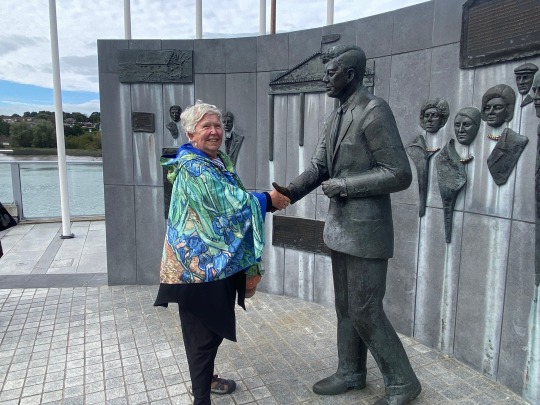

The ship above is the Dunbrody, a replica for the type of ships that brought so many Irish emigrates to the US (including JFK's great grandfather) during and following the Great Hunger. Between 1835 and 1865 Ireland lost 1/2 of their entire population to emigration or death. Sadly, the other name for this ship is a "coffin ships" which needs no explanation. Today's population is still less that it was in 1835. Think about that!

The last thing at this site was the memorial to all the emigrants and it is lit with an eternal flame - lit from the eternal flame that is on President Kennedy's grave. On June 22, 2013, - 50 years to the day since JFK's visit, Caroline Kennedy Schlossberg and her aunt Jean Kennedy Smith arrived carrying the flame from Arlington Cememtery to light this memorial. Very nice.
The following day we left early to visit Blarney Castle. We visited Ireland 4 years ago and starting in Dublin worked our way counter-clockwise around the island until we reached Dingle and made our way back to Dublin. (route in black)

Four years ago, we opted to skip the Blarney Castle ruin because we had no interest in kissing any stone that would give me the gift of gab. On this trip we are doing the red route and while we still opted out of the kiss - we did visit the ruin and the beautiful grounds and had a glorious day.





The following day we left sweet Cork and drove to Waterford to visit the Waterford Crystal factory. Interesting to say the least - but there will be none of that in our future. But I will say that these workers are artists - for sure. Below I'm holding a 14 pound golf trophy worth who knows how much money. OMG!!
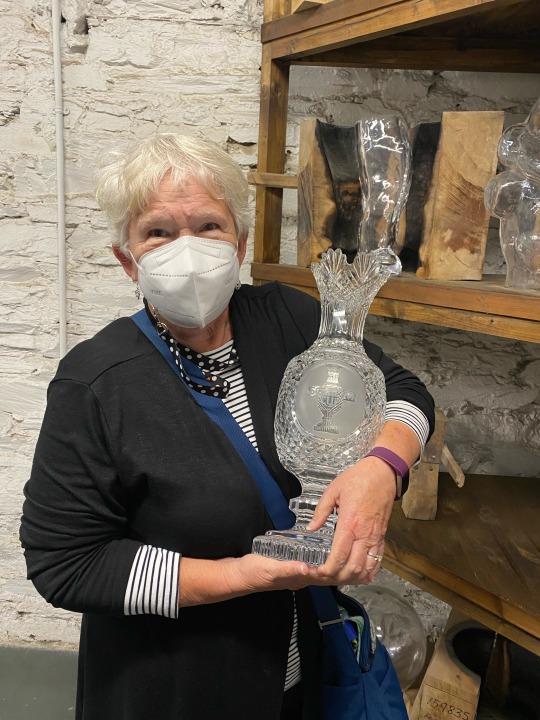
Some truly amazing stuff:
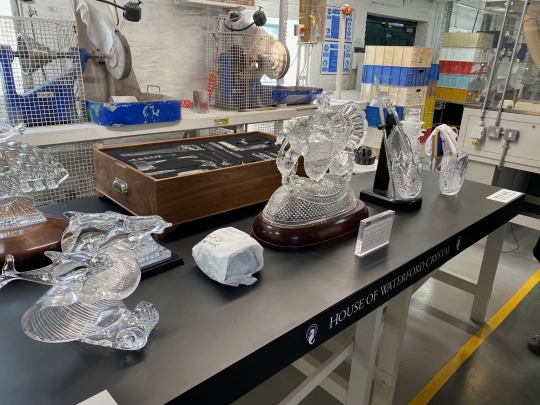
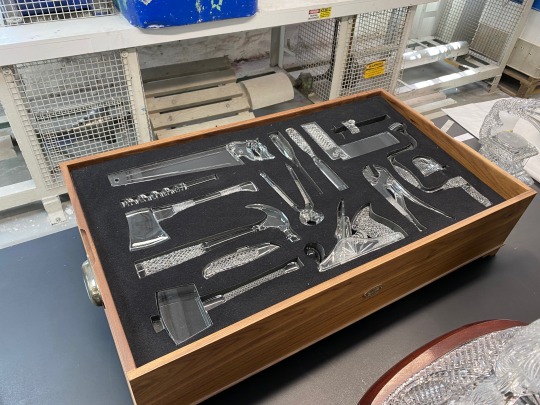
These tools are awesome - but clearly not worth a damn.
We did learn that anytime that you have a place that ends in the word "ford" was once "fjord". Yes Ireland was once Viking territory! And while in Wexford - we found this:

That same night - back at the hotel in Wexford a nice gentleman informed us that at 9:00 PM upstairs there would be Irish dancing and he kindly invited us to attend. How nice - we graciously accepted
We went- but it was NOT what we thought. (We were thinking River Dance...) Instead it was about 100 Irish people who had traveled there to dance. The dances they did were folk dances in groups of 8 and as the fiddle and accordion played they went at it. It was DELIGHTFUL to watch but soon, they were trying to get us to join urged on my the man playing the fiddle. "There are some wonderful Americans sitting at that table right there. Get yourself an American and let's show them a good time. OMG!!! It looked like a stampede toward our table. Some of our travel mates gave it a go.
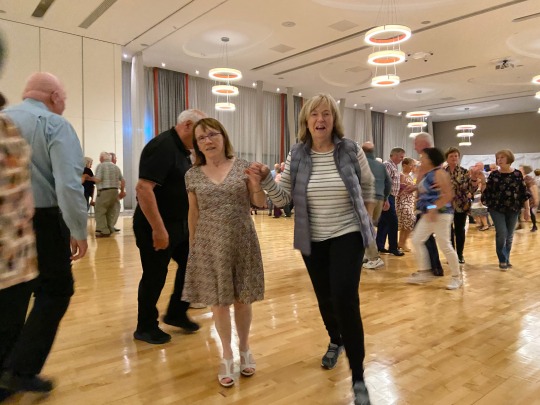
We escaped to our room....
We have a big day planned for tomorrow. Time to rest! Stay tuned.
Loving Ireland!
0 notes
Photo
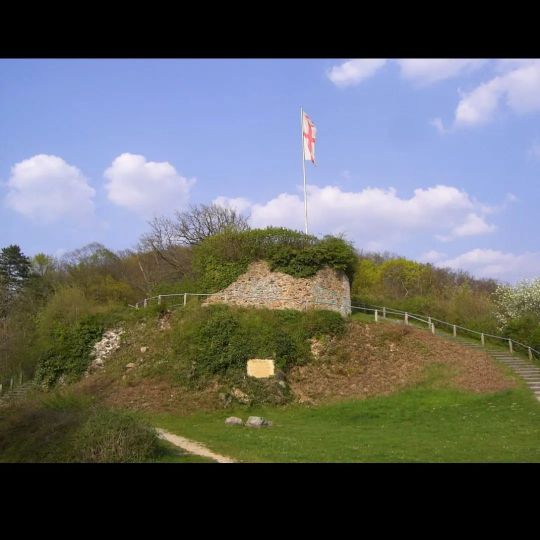
The part of once castle in #Schloßberg, now only ruin - from wiki. #Folktale from #graz #austria🇦🇹 Many years ago, a farmer from Auerbach was walking past Schloßberg in the evening. Suddenly he was stopped by an old man -so old that he was bent to his knees. The old man said, "Come with me - you have some work." The farmer said, "But I need to go to get manure." The old man threatened him, "If you don't come, you have to face the consequence." Thus the old man forced him to climb up to the castle. The farmer was found the other day on a dark step of the castle. He was terribly tired then. He died shortly thereafter. *the story, obviously developed looks incomplete or too short be called a story. Local belief is that the #devil himself created Schlossberg. He had once promised the people of Graz that he would make their local mountain, the Schöckl, higher in exchange for the first soul climbing up heightened Schöckl. It was an Easter Sunday when he came flying over Graz with a huge rock from Africa in his hands. Suddenly he caught sight of a procession. But he had no power over humans on the holy day to be able to grab a soul. In wicked anger, he threw the rock onto the town. The rock broke in two parts - the smaller one is Austein and the bigger, Schlossberg. History of the castle of Schloßberg is at least one thousand year old. In mid 16th century, the Italian Domenico del'Aglio built a large mighty fortress here which even Napoleon could not capture. Like all other #European #castles this also went through ravishing wars; also changed hands. However the clock tower and The bell tower adorned with The haviest bell of Graz were preserved. The story shows how much awe #medieval castles inspired among common people. Castles were considered home for #supernatural beings those became cause of death. Perhaps the once tormentor nobility who lived in the castles remained alive in people’s memory as supernatural beings who capture loners and kill them without provocation? However, the castle does not exist today, a #tourist destination came up in it's place. #sagen #grimm https://www.instagram.com/p/CefctXNL3oF/?igshid=NGJjMDIxMWI=
#schloßberg#folktale#graz#austria🇦🇹#devil#european#castles#medieval#supernatural#tourist#sagen#grimm
0 notes
Text
Schlossberger Castle, Tura, Hungary

0 notes
Photo

Schossberger Kastély, Tura, Hungary,
#art#design#architecture#hungary#tura#castle#kastély#schlossberger kastély#luxurylifestyle#luxuryhouse#luxuryhome#style#history
342 notes
·
View notes
Photo

Schlossberger Castle, Tura, Hungary
3 notes
·
View notes
Photo

Schlossberger Castle, Tura, Hungary
1 note
·
View note
Photo
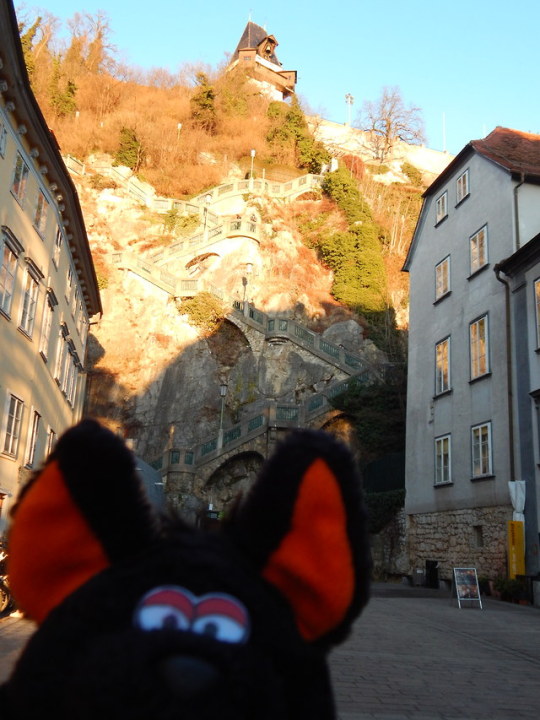
awesome it's me again.....sarcasm
.....darn....walk up and you're at a castle.....
#graz#austria#österreich#vacation#holiday#trip#eric#eric van norton#europe#schlossberg#castle#city#steps
1 note
·
View note